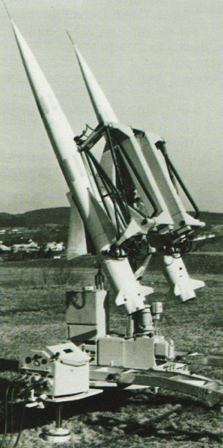Vaccari Passero
| Vaccari Passero Falco-C | |
|---|---|
 | |
| Type | Surface-to-air missile |
| Place of origin | |
| Service history | |
| In service | 1958 - 1986 |
| Used by | Lumenic Air Force |
| Production history | |
| Designed | 1958 |
| Manufacturer | Vaccari |
| Unit cost | between |
| Produced | 1958 - 1972 |
| Variants | Areiva Corvo |
| Specifications | |
| Weight | missile: 400 kg (880 lbs) |
| Length | 6 m (19.8 ft) |
| Diameter | 40 cm (15.7 in) |
| Warhead | 40kg warhead |
| Wingspan | 134 cm (53 in) |
Operational range | 30,000 m (18.6 mi) |
| Flight ceiling | 9,000 m (29,930 ft) |
| Speed | Mach 2.4 (800m/s) |
Guidance system | Beam riding |
The Vaccari Passero, sometimes referred to as the Falco-C, is a surface to air missile system developed by Vaccari of Luminerra for the Lumenic Air Force and the international commercial market. It is a development of the earlier Vaccari Falco missile and served as the backbone of the Air Force's air defense's into the 1980's when it was replaced fully by the Areiva Corvo.
History and design
The Vaccari Passero was a liquid-fueled rocket-powered missile, guided to its target by riding a radar beam. The missile body was made of wrapped tubing and sheet with Araldite bonding while the wings were of sandwich construction.
Targeting was by search radar and beam transmitter with targets tracked by a search radar until a beam riding transmitter locked on, at which point the missile could be fired, riding the beam until impact, proximity fuse or radio signal detonation. Launchers, slaved to the beam transmitter could launch missiles at any angle form 10° to 90° at a sustained rate of fire of up to two launches per minute. Control of the missiles was by vectoring rocket motor combustion chamber at launch and controllable rear fins at higher speeds. The complete system included a battery command post, target tracking radar, guidance beam transmitter and six twin railed trainable launchers and four diesel generator units. The components were carried on single-axle trailers apart from the diesel generators that were built on two-axle trailers. The entire system, including the launchers, was readily transportable to new locations with mobility claimed to be similar to that of a heavy anti-aircraft gun system.